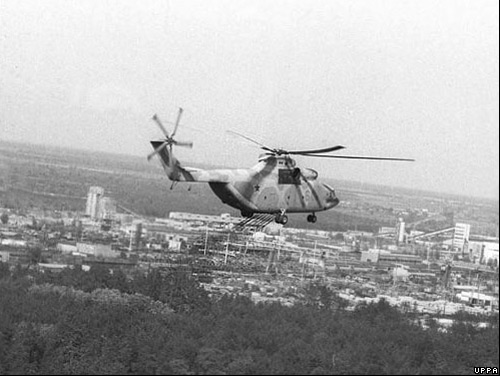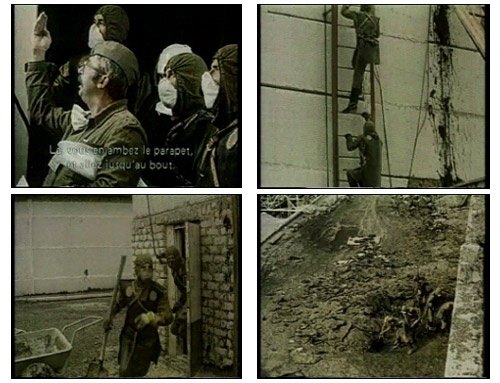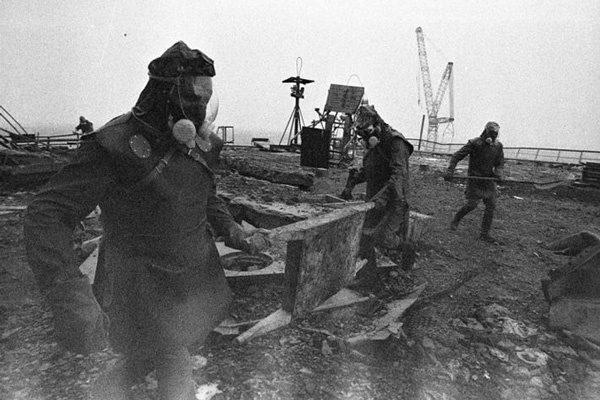A heavy toll paid by firefighters and liquidators:
The magnitude of the disaster took the Soviet authorities by surprise. The urgency imposed dramatic conditions, but the habit of secrecy, combined with that of not having to be accountable, have lead these authorities to have hidden several days the nature and magnitude of the accident.

Air drops by helicopters
The plant personnel, firefighters and soldiers struggled to put the reactor under control. Helicopters were used to dump tons of sand and various materials on the ruins of the reactor to reduce the dispersion of radioactive materials and direct exposure to radiationose. Helicopter pilots were among those to intervene. Poorly protected, they received large amount of radiation and some of them paid with their lives their intervention.
© BBC News
The first intervention was that of firefighters who had to put out a gigantic fire fueled by the large mass of graphite present in the reactor core. The fire lasted for almost a week. 600 firefighters participated in this extinction, during which they were exposed to an intense heat combined to a very intense radioactivity.
Among these firefighters, 134 suffered from acute radiation syndrome which led to 40 deaths, to which must be added 19 deaths due to radio-induced burns. Tons of material were then dumped by helicopter to reduce the spread of radioactive material. Even flying over the reactor exposed to significant doses.

An early intervention after the disaster
These images are taken from a film made during an early intervention intended to remove fragments of radioactive graphite from the roof of the twin reactor N°3. They say more than words, the heroism of firemen crews who were the first to intervene, the emergency, the derisory means given the magnitude of the disaster, the poignant absence of a significant radiation protection. This involves climbing onto the roof of the neighboring reactor to clean it of highly radioactive debris that has fallen after the explosion.
© CNRS/Images-Media
As a result of the explosion, the installation was covered with pieces of highly contaminated graphite, originating from the core used to slow down the neutrons in the RBMK reactors. A large amount of radioactive graphite debris was found in particular on the roof of the neighboring No. 3 unit. The debris had to be cleaned up.
After tons of materials were dumped by helicopter, began the cleanup and the construction of a sarcophagus. They were hundreds of thousands to participate in these operations which lasted six months. They were called the liquidators. During some of the early interventions, radioprotection measures were limited to a simple handkerchief over his nose and mouth. For some firefighters and soldiers, protective measures were limited to a simple tissue over nose and mouth. Some conscripts were drafted without be much informed about the risks that they face.

Cleaning of radioactive debris on the roof of unit N°3
The job had to be done by human hands. A subset of liquidators were deployed to the unit N°3 roof top. After climbing a ladder, they would run on the roof for a few minutes or less, removing just a few shovels of waste before a new crew of liquidators would take their turn.
© Igor Kostin / Novosti Press Agency
An estimated 350,000 people, including soldiers, the plant staff, local police and firefighters were involved in 1986 and 87 in the emergency measures and the containment and cleanup operations. Among them, 240,000 took part in major operations to mitigate the consequences of the accident at the reactor and in the exclusion zone.
Later on the number of people registered as liquidators rose to 600,000. The exposures were very unequal. Some liquidators were exposed to high radiation levels, especially among the first teams that intervened on the site.
The liquidators medical monitoring is difficult since they belong to different nationalities (Russian, Ukrainian, Estonian …) and they are now scattered throughout these republics of the former Soviet Union. The average dose from external radiation for the Russian liquidators, calculated from official data, is 108 mSv, 4.2% of liquidators having received more than 250 mSv.
The calculations on the number of victims are uncertain. By applying the rule of « LNT » recommended by the ICRP (International Commission on Radiological Protection), 3000 among the 600 000 liquidators of Chernobyl may die one day as a result of their exposure. This estimate assumes that the proportion between the number of deaths and the dose is the same as the proportion that was observed among the victims of Hiroshima and Nagasaki. At the individual level, it will not be possible to distinguish cancers due to the accident from cancers due to other causes. Moreover, an excess of suicides was reported. The plight of the liquidators is also one of the consequences of the disaster.
The liquidators distress is sometimes increased by estimates not always based on reality. On the occasion of the twenty-fifth anniversary of the accident, a french television channel reported 400,000 deaths among the 600,000 liquidators. The same media reassessed to a million the total number of deaths from accident, 250 times the 4000 estimated in 2011 by the IAEA and ICRP agencies recognized for their competence and scientific honesty.
Inflation in numbers does not mean truth. With no ways to actually count the victims, passions and ideologies unfortunately, dominates often over reason. There is the temptation to exploit fears. Before diving into anxiety a Chernobyl liquidator by stating that two-thirds of his comrades have already died, one should check the veracity of such calculations.
« Liquidators Endured Chernobyl 25 Years Ago » : Diaporama National Geographic Magazine
Other articles on the subject « Chernobyl accident »
Chernobyl Circumstances
An explosion followed by a graphite fire In 1986 the Ukrainian Chernobyl plant had 4 RBMK reactor[...]
Radioactive Releases
Radioactive releases and contaminations at Chernobyl The explosion of the reactor led to the disp[...]
Chernobyl Plume
A deep mark in the french collective unconscious « The Chernobyl cloud has stopped at the french [...]
Chernobyl Exclusion Zone
A no man’s land turned into a natural reserve ? On April 27th, 1986, one day after the expl[...]
Chernobyl Health Effects
Chernobyl: A toll still impossible to quantify It is difficult to reach an approached assessment [...]
Chernobyl Iodine 131
A dangerous radioelement during the first weeks Iodine-131 is the most feared fission product whe[...]
Chernobyl Caesium-137
The accident long term legacy More than twenty years after the Chernobyl accident, attention focu[...]
Chernobyl Today
The Chernobyl Site Over 30 Years Later On December 15, 2000, the Ukrainian government, in accorda[...]